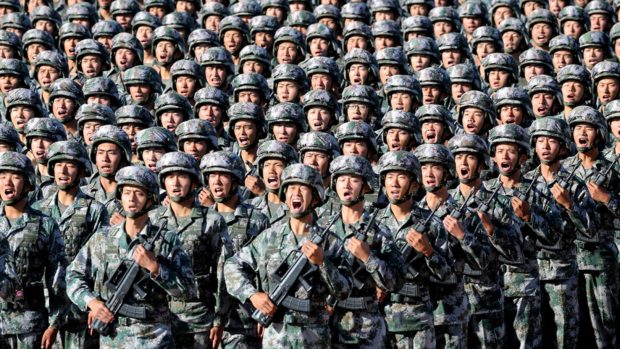
Increasing activities by China in depth areas of eastern sector: Eastern Army Commander
PTI, Oct 19, 2021, 12:01 PM IST

Image for Representation
China has increased the intensity of carrying out military drills and deployment in its depth areas opposite the Arunachal Pradesh sector and India has correspondingly readied contingency plans to deal with any security challenges in the region, Eastern Army Commander Lt Gen Manoj Pande said on Tuesday.
Giving an account of India’s overall military modernisation, Lt Gen Pande also said that an in-principle approval has been given to new combat formations called the Integrated Battle Groups (IBGs) which can mobilise fast with a more effective approach.
The IBGs will comprise a mix of infantry, artillery, air defence, tanks and logistics units and the new set up is expected to revamp the Army’s war fighting capabilities, particularly along the borders with China and Pakistan.
Lt Gen Pande added that the plan to operationalise the 17 Mountain Corp has been implemented in sync with a plan finalised in 2014.
”The annual training exercise that the PLA carries out there has seen some increase in the level of activities in the depth areas. Some of the reserve formations which the PLA mobilised continue to remain in their training areas that are in the operational depth areas,” he said.
”Both sides are attempting to develop infrastructure closer to the Line of Actual Control (LAC) that create certain issues at times,” he said, adding there has been an increase in deployment of troops following the development of new infrastructure.
The commander said India has taken a number of steps and the foremost among them is enhancing surveillance both close to the LAC and the depth areas by synergising all surveillance resources right from the strategic level to the tactical level.
”We have adequate forces that are available in each sector to deal with any contingency that may arise. We are practising and rehearsing various contingencies that may arise,” he said.
Asked about the recent agreement between China and Bhutan to resolve their decades-old boundary dispute and whether it will impact India’s strategic interests in the areas around Doklam tri-junction, the Army Commander did not give a direct reply but said authorities concerned in the government must have taken note of the pact. On China violating various border agreements and protocols, Lt Gen Pande indicated that the issue is being discussed at a higher level.
”In terms of our larger guidance, strategic guidance in terms of dealing with situation on the LAC is to respect the mutually agreed protocols and agreements, and that has been our effort, notwithstanding what has been the action or response from the other side,” he said.
”Consequent to what happened and what we need to do in the future, is something I reckon is being looked into at the larger level,” he said.
A fourth hotline between the two sides has been activated recently, he added.
As tensions increased following the eastern Ladakh row last year, India ramped up overall deployment of troops along the nearly 3,400 km LAC besides speeding up infrastructure development to gain tactical advantage.
The Army is also cranking up its day and night surveillance over the LAC in the region using a fleet of remotely piloted aircraft A sizeable fleet of Israeli-made Heron medium-altitude long endurance drone is carrying out round-the-clock surveillance over the LAC in the mountainous terrain and sending crucial data and images to command and control centres.
Along with the drones, the Indian Army’s aviation wing has also been deploying the Weapon System Integrated (WSI) variant of the Advanced Light Helicopter Rudra in the region adding more teeth to its tactical missions in the region, they said.
The government is also working on connecting Tawang with a railway network as part of the decision to enhance infrastructure in the region.
The eastern Ladakh border standoff between the Indian and Chinese militaries erupted on May 5 last year following a violent clash in the Pangong lake areas and both sides gradually enhanced their deployment by rushing in tens of thousands of soldiers as well as heavy weaponry.
The tension escalated following a deadly clash in Galwan Valley on June 15 last year.
As a result of a series of military and diplomatic talks, the two sides completed the disengagement process in Gogra area in August and in the north and south banks of the Pangong lake in February.
The last round of military talks on October 10 ended in stalemate following which both sides blamed each other for the impasse.
In a strong statement after the 13th round of talks, the Indian Army said the ”constructive suggestions” made by it at the negotiations were neither agreeable to the Chinese side nor Beijing could provide any ”forward-looking” proposals.
Each side currently has around 50,000 to 60,000 troops along the LAC in the sensitive sector.
Udayavani is now on Telegram. Click here to join our channel and stay updated with the latest news.
Top News

MUST WATCH
Latest Additions

Wanted to kill Ajmal Kasab who caused so much of pain, recalls 26/11 terror attack victim

Two retired revenue officials among four arrested in land grabbing case in Jammu

Kerala govt to revise manual for junior doctors, house surgeons

State can interfere with religious practices if they impede development, equality rights: SC

Four cheers at MP’s Kuno park; cheetah Neerva gives birth to cub quartet
Thanks for visiting Udayavani
You seem to have an Ad Blocker on.
To continue reading, please turn it off or whitelist Udayavani.


















